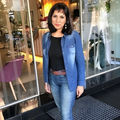Interviews
Optical fibres-based magic carpet can help prevent falls
06 Sep '12
4 min read
A ‘magic carpet’ which can immediately detect when someone has fallen and can help to predict mobility problems has been demonstrated by University of Manchester scientists.
Real-time imaging of walking patternsPlastic optical fibres, laid on the underlay of a carpet, can bend when anyone treads on it and map, in real-time, their walking patterns.
Tiny electronics at the edges act as sensors and relay signals to a computer. These signals can then be analysed to show the image of the footprint and identify gradual changes in walking behaviour or a sudden incident such as a fall or trip. They can also show a steady deterioration or change in walking habits, possibly predicting a dramatic episode such as a fall.
As many as 30%-40% of community dwelling older people fall each year. This is the most serious and frequent accident in the home and accounts for 50% of hospital admissions in the over 65 age group.
Presenting their research to the Photon 12 conference today, the scientists believe the technology could be used to fit smart carpets in care homes or hospital wards, as well as being fitted in people’s homes if necessary. Physiotherapists could also use the carpet to map changes and improvements in a person’s gait.
The imaging technology is so versatile it could even be developed to detect the presence of chemical spillages or fire as an early-warning system.
The interdisciplinary team, from three academic Schools and the Photon Science Institute at The University of Manchester, used a novel tomographic technique similar to hospital scanners.
It maps 2D images by using light propagating under the surface of the smart carpet.
The researchers, led by Dr Patricia Scully from The University of Manchester’s Photon Science Institute, believe the magic carpet could be vital not only for helping people in the immediate aftermath of a fall, but also in identifying subtle changes in people’s walking habits which might not be spotted by a family member or carer.
Dr Scully said: “The carpet can gather a wide range of information about a person’s condition; from biomechanical to chemical sensing of body fluids, enabling holistic sensing to provide an environment that detects and responds to changes in patient condition.
“The carpet can be retrofitted at low cost, to allow living space to adapt as the occupiers’ needs evolve – particularly relevant with an aging population and for those with long term disabilities – and incorporated non-intrusively into any living space or furniture surface such as a mattress or wall that a patient interacts with.”
Popular News
Leave your Comments
Editor’s Pick
































-Ltd..jpg?tr=w-120,h-60,c-at_max,cm-pad_resize,bg-ffffff)





.jpg?tr=w-120,h-60,c-at_max,cm-pad_resize,bg-ffffff)
.jpg?tr=w-120,h-60,c-at_max,cm-pad_resize,bg-ffffff)






